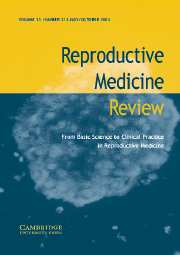Article contents
Therapeutic insemination by donor I: A review of its efficacy
Published online by Cambridge University Press: 03 June 2009
Extract
Of all the assisted reproductive technologies in current use, artificial insemination has by far the longest history. While the earliest verifiable reports using this technique date to the eighteenth century for nonhuman artificial insemination and to the nineteenth century for human artificial insemination, systematic use of this approach to assist reproduction did not occur until the early part of this century. During the early 1900s, in Russia, Ivanov developed methods for semen collection from and insemination of horses. These techniques were later modified to apply to other agriculturally important species so that by the 1930s, millions of horses, cattle and sheep were being bred using artificial insemination. The adaptation of widespread use of artificial insemination (primarily in cattle) in agriculture extended to Britain in the early 1940s and to the USA in the 1950s. Corresponding implementation of artificial insemination in human reproductive medicine closely followed these innovations in the animal husbandry field.
- Type
- Articles
- Information
- Copyright
- Copyright © Cambridge University Press 1995
References
- 8
- Cited by


